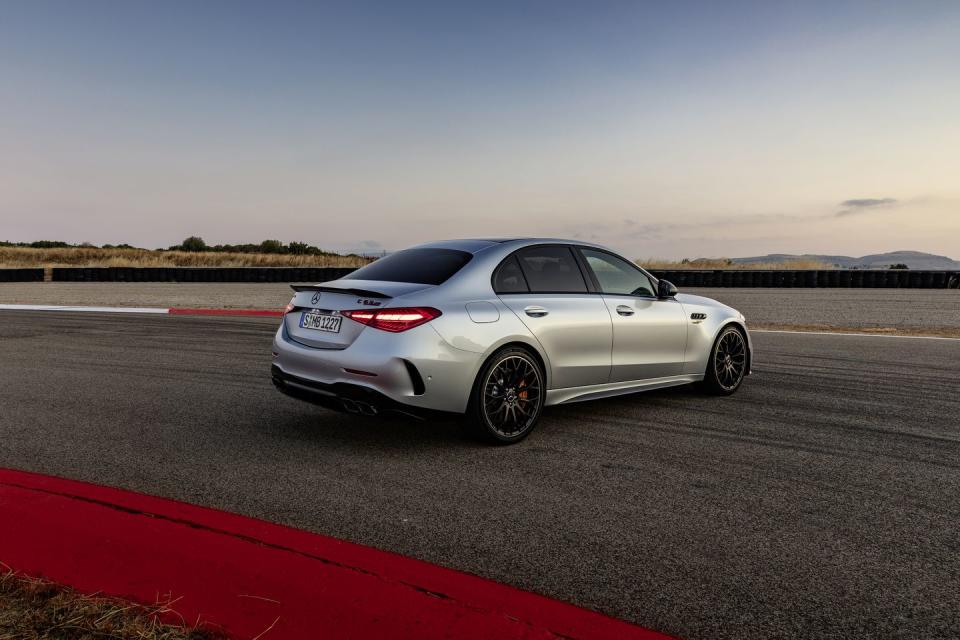I Feel Conflicted About the New Mercedes-AMG C 63

The fact that we've known for some time that the Mercedes-AMG C 63 would drop its characterful V-8 for four-cylinder power softened the blow somewhat. Yet, I still felt a sense of ennui when the new—deep breath—Mercedes-AMG C 63 S E Performance was revealed a couple days ago.
As implied by the "E Performance" in the name, the new C 63 is a hybrid. AMG combines a 2.0-liter four-cylinder with a motor on the rear axle for a total output of 671 hp and 752 lb-ft of torque. The engine on its own makes a staggering 476 hp and 402 lb-ft of torque, its 238 hp/liter besting the Ferrari 296's 218.6. That much power from such a small capacity might lead you to think this engine would be unbearably laggy, but AMG employs an F1-esque turbocharger whose turbine is spun by an electric motor for immediate response. The all-wheel-drive system is fully variable, and the rear-axle motor at the rear is even capable of sending power to the front.

There is no doubt that the engineering is fascinating. Yet the drawback with the hybrid system is weight—Mercedes-AMG says the new C 63 weighs 4654 pounds. Yeesh.
Of course, the old C 63 was heavy, tipping the scales at around 4000 pounds, though it didn't matter all that much. The car was more of a laugh than anything else, less serious than the BMW M3, defined by that muscular, sonorous 4.0-liter V-8. It was a feel-good car. The new C 63 has a better power-to-weight ratio than its predecessor, yet I'm struggling to care. I just imagine a car that will generate impressive numbers without being all that much fun.
On the road, will you really be able to use 680 hp and 752 lb-ft of torque? Outside of Germany, no. Plus, it's not as if the old C 63 wasn't more than quick enough. The weight of the hybrid system just doesn't seem to outweigh the benefits that can be exploited.
I'm very willing to be wrong. This unique hybrid powertrain does provide for some interesting opportunities in how power is deployed, plus modern chassis and tire technology can do a lot to deal with weight. I'm not even anti four-cylinders either! Yet, if I were devising a recipe to create a perfect small luxury sports sedan, it would look a lot like what went into the last C 63.

Mercedes-AMG was probably boxed in here. Mercedes decided some time ago that the W205-chassis C-Class would only get four-cylinder power across the range. As the W205 is a heavy revision of the old W204 C-Class, we suspect the V-8 would fit under the hood, and given that engine is capable of well over 600 hp, AMG could've easily tuned it to exceed the old C 63 S's 503 hp. (Not to mention the current M3 Competition's 503 hp.) Yet, AMG can't just stick V-8s in everything these days, fuel-economy and emissions regulations being what they are. Likely, there were no good six-cylinder options either. Mercedes has wound down V-6 production in favor of a new straight-six, which is likely too long for the C-Class.
So, four-cylinder hybrid it is, but what if Mercedes skipped the hybrid part? Then you'd have something that looks a lot like the new C 43, which uses a 403-hp version of the AMG four-cylinder and weighs 3893 pounds. Now, I'm not saying it would've been enough for AMG to take a C 43, turn the boost up, fit wider tracks and call it a C 63, yet strangely, the lower-tier car seems more appealing.
What's even more appealing? The M3, or better still, the Cadillac CT4-V Blackwing. Both are very complex cars, yet both stick to the simple formula of six-cylinder power, automatic or manual transmission, rear-wheel drive, or all-wheel drive in the case of the M3 Competition xDrive. It's a formula that just works.
I am, of course, very intrigued by the new C 63. I just worry that it's evidence we're headed in the wrong direction.
You Might Also Like

 Yahoo Autos
Yahoo Autos 